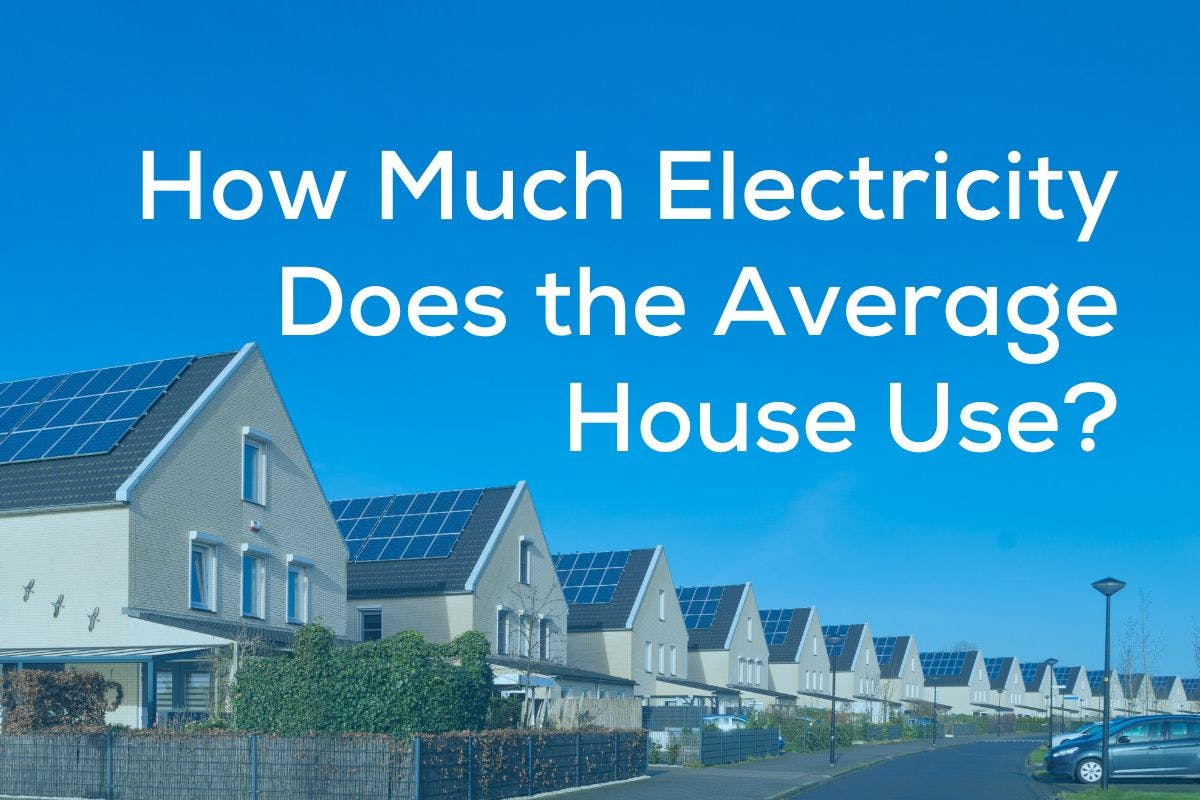Electricity was sold for the first time in the US in 1879. In San Francisco, the California Electric Light Company sold the energy for 21 electric–brush arc light–lamps.
In 2023, the US used a record-high 4.18 trillion kilowatt-hours of electricity. The country’s electricity usage is more than 14 times more than what it was in 1950. The US and the world are projected to use more electricity every year until at least 2050. That electricity is used by businesses, data centers, cars, street lights, still 146 years later, and our homes.
If you can reduce your sliver of the trillions of kilowatt-hours, you can save money. Using renewable solar power is another way to save money, have more energy independence, and use cleaner energy. Here are ways to use less energy in our homes.
See how much you can save with home energy changes
How Much Electricity Do We Use? (And How Much Does it Cost?)
In 2023, the average residential property in the US used 855 kilowatt-hours a month according to the US Energy Information Administration, though it varies by state or region. Your consumption depends on many factors, like the season, how many people live at home, whether you work from home, your appliances, and the age of the house itself.
Your monthly bill depends not only on your consumption, but also on your utility’s rate. The average rate nationwide as of January 2025 was 15.95 cents per kWh. It was 15.44 cents per kWh in January 2024, and an average of 16.48 cents for 2024 as a whole. The average monthly electric bill for more than 141 million US homes was $136.84 in 2023 according to the EIA.
States with the highest average consumption don’t always have the highest bill. In 2023, Louisiana had the highest consumption with 1,238 kWh per month. (Much of the Deep South, southwest, Mid-Atlantic, and Great Plains have higher kWh usage as residents tend to use air conditioning more often for more of the year.) California has the lowest average electricity consumption of 491 kWh a month. The difference in average rates adds up to California’s average monthly bill being $144.81 and Louisiana’s being $142.96.
The highest average bill goes to Hawaii at $213.23 a month and, in the continental US, Connecticut at $202.74. The lowest average bill is in Utah at $84.97.
| State | Average rate (cents per kWh) | Average kWh consumed (per residence per month) | Average monthly bill | Average bill rank |
|---|---|---|---|---|
| Alabama | 15 | 1,112 | $162.67 | 45 |
| Alaska | 24 | 577 | $137.88 | 30 |
| Arizona | 14.02 | 1,059 | $148.44 | 40 |
| Arkansas | 12 | 1,049 | $128.51 | 26 |
| California | 30 | 491 | $144.81 | 38 |
| Colorado | 14.3 | 662 | $94.65 | 3 |
| Connecticut | 29.88 | 678 | $202.74 | 50 |
| D.C. | 16.45 | 631 | $103.85 | 5 |
| Delaware | 15.73 | 878 | $138.04 | 31 |
| Florida | 15.21 | 1,107 | $168.35 | 48 |
| Georgia | 13.69 | 1,035 | $141.67 | 35 |
| Hawaii | 42.39 | 503 | $213.23 | 51 |
| Idaho | 11.05 | 965 | $106.65 | 7 |
| Illinois | 15.71 | 669 | $105.11 | 6 |
| Indiana | 14.94 | 876 | $130.90 | 28 |
| Iowa | 13.31 | 846 | $112.60 | 13 |
| Kansas | 13.38 | 881 | $117.91 | 19 |
| Kentucky | 12.65 | 994 | $125.80 | 21 |
| Louisiana | 11.55 | 1,238 | $142.96 | 36 |
| Maine | 27.42 | 560 | $153.56 | 44 |
| Maryland | 16.6 | 894 | $148.45 | 41 |
| Massachusetts | 29.61 | 559 | $165.55 | 46 |
| Michigan | 18.84 | 603 | $113.62 | 15 |
| Minnesota | 14.73 | 752 | $110.78 | 10 |
| Mississippi | 13.23 | 1,157 | $153.07 | 43 |
| Missouri | 12.58 | 1,003 | $126.09 | 23 |
| Montana | 12.54 | 873 | $109.50 | 9 |
| Nebraska | 11.2 | 996 | $111.52 | 12 |
| Nevada | 16.67 | 874 | $145.62 | 39 |
| New Hampshire | 28.15 | 600 | $168.79 | 49 |
| New Jersey | 17.7 | 639 | $113.21 | 14 |
| New Mexico | 13.85 | 659 | $91.20 | 2 |
| New York | 22.24 | 566 | $125.80 | 22 |
| North Carolina | 12.93 | 989 | $127.79 | 25 |
| North Dakota | 11.01 | 1,069 | $117.69 | 18 |
| Ohio | 15.38 | 811 | $124.68 | 20 |
| Oklahoma | 12.08 | 1,069 | $129.10 | 27 |
| Oregon | 12.73 | 924 | $117.66 | 17 |
| Pennsylvania | 18.1 | 791 | $143.10 | 37 |
| Rhode Island | 27.02 | 554 | $149.78 | 42 |
| South Carolina | 13.68 | 1,022 | $139.91 | 33 |
| South Dakota | 12.32 | 1,025 | $126.31 | 24 |
| Tennessee | 12.19 | 1,109 | $135.22 | 29 |
| Texas | 14.46 | 1,146 | $165.82 | 47 |
| Utah | 11.2 | 759 | $84.97 | 1 |
| Vermont | 20.82 | 563 | $117.11 | 16 |
| Virginia | 14.26 | 993 | $141.63 | 34 |
| Washington | 10.96 | 977 | $107.35 | 8 |
| West Virginia | 14.05 | 986 | $138.56 | 32 |
| Wisconsin | 16.88 | 658 | $111.06 | 11 |
| Wyoming | 11.46 | 866 | $99.24 | 4 |
Data from EIA.
What Are a House’s Biggest Electricity Consumers?
In 2020, air conditioning used 19% of electricity in residential settings in the US, and was the largest residential electricity consumer according to data from the US Energy Information Administration. Heating and water heating used about 12% each. Lighting, refrigeration, TVs and related devices, and laundry dryers are next going down the list.
Heating and cooling accounted for about 52% of overall residential energy usage in 2020. HVAC efficiency is improving, so it’s declining as a percentage of a home’s energy usage. Yet, the total gross energy usage, electric and total, is increasing as more homes and buildings have heating and cooling. In 1980, 57% of US homes had air conditioning. As of 2020, it was 88% of US homes.

Home Electrification and Energy Consumption
If you’re electrifying your whole home, some of your appliances, or your vehicle, you might be trying to cut your overall energy consumption. As you’re moving to smart thermostats and electric heat pumps, laundry, and cars, it makes sense you’ll use more electricity and less of other forms of energy (mostly gas).
That means you’re likely to get a higher electric bill. If you’re looking to save money when you electrify your home, the increased electricity cost needs to be smaller than the decrease in overall energy cost.
Combining an electric heat pump and a smart thermostat may give you a more energy-efficient HVAC system year-around as the thermostat “learns” your settings and patterns and adjusts the home’s heating and cooling in the most efficient way possible. That’s just one strategy for curbing your energy use.
Home solar panels can replace some of the electricity you’d normally buy and save you even more. This can help insulate you from rising utility company rates, increase your energy independence, and make a bigger environmental difference.
See how much you can save with home energy changes
Solar Panels and Energy Consumption
If you had your own renewable electricity source on your home, it would make sense to run as many of your home appliances and systems on that electricity as possible.
Solar panel systems are designed to last for 25 or more years. Although there’s a cost to buying a residential solar system, you’re paying today for the electricity you generate and use for decades to come. You can save money monthly by reducing or even eliminating your usual utility bill. Many solar panel systems pay for themselves through savings in a matter of years.
Other Ways to Use Less Electricity
There are plenty of strategies, from the simple to the more complicated, that can lead to saving energy. A home energy audit checks a home’s energy efficiency by inspecting where air, hot or cold depending on the season, can escape your home. An energy audit checks insulation, the foundation, walls, siding, chimney, caulking, window and door frames, vents, crawl spaces, and attics. It can be done by a pro or you can do parts of it yourself.
If it’s time for a new appliance, pay attention to its energy efficiency. Look for the Energy Star certification and know about any incentives or tax credits you may qualify for. Most appliances are sold with an Energy Guide label that will give its average consumption and cost over a year of normal use.
An easier, less expensive step is checking the light bulbs around your house. LED light bulbs use at least 75% less energy and last 25 times longer than incandescent bulbs.
Smart plugs can monitor energy usage, stop vampire energy consumption, and turn appliances on or off via an app, which can be a major safety plus.
You can use ceiling fans year-around to reduce your need for heating and cooling. We usually turn a fan on to make it feel cooler, but you can reverse the direction of a ceiling fan to move warmer air down in cool or cold months. Running the fan doesn’t actually change the temperature in a room, it makes it feel warmer or cooler, by up to four degrees, so you can adjust your thermostat accordingly.
See what home electrification can do for you:
Home Energy Consumption FAQs
Why is my electricity bill so high?
The price of electricity has increased over the last year. From July 2023 to July 2024, the nationwide average rate has gone from 15.89 cents per kWh to 16.62. Your home’s bill may vary due to weather, number of people at home, your daily schedule and habits, the age of the home, your appliances, and more.
Which states have the highest and lowest electricity bills?
By the average monthly bill in 2023, Hawaii was the most expensive US state with an average electric bill of $213.23. Utah was the least expensive state with an average bill of $84.97. By rate, Hawaii had the most expensive electricity rate and Washington had the lowest electricity rate.
How much electricity does AC use?
Air conditioning is typically the biggest user of energy in a home in the US. According to the EIA, AC used about 19% of residential electric consumption in 2020. Heating plus cooling used about 52% of a home’s overall energy consumption as of 2020. In 2023, the average monthly electric bill for more than 141 million US homes was $136.84, with the average home using 855 kWh a month. Taking 19% of those numbers equals $26.00 and 162.5 kWh.
 Andrew GiermakWriter and Editor
Andrew GiermakWriter and EditorAndrew joined Palmetto in Charlotte in August 2024. He’s been a writer in journalism, then in business, going back to almost the 20th century. He’s lived in Indiana, Virginia, Pennsylvania, Virginia again, and now North Carolina for the last 12 years. He likes golf. Is he good at it? Not so much.

